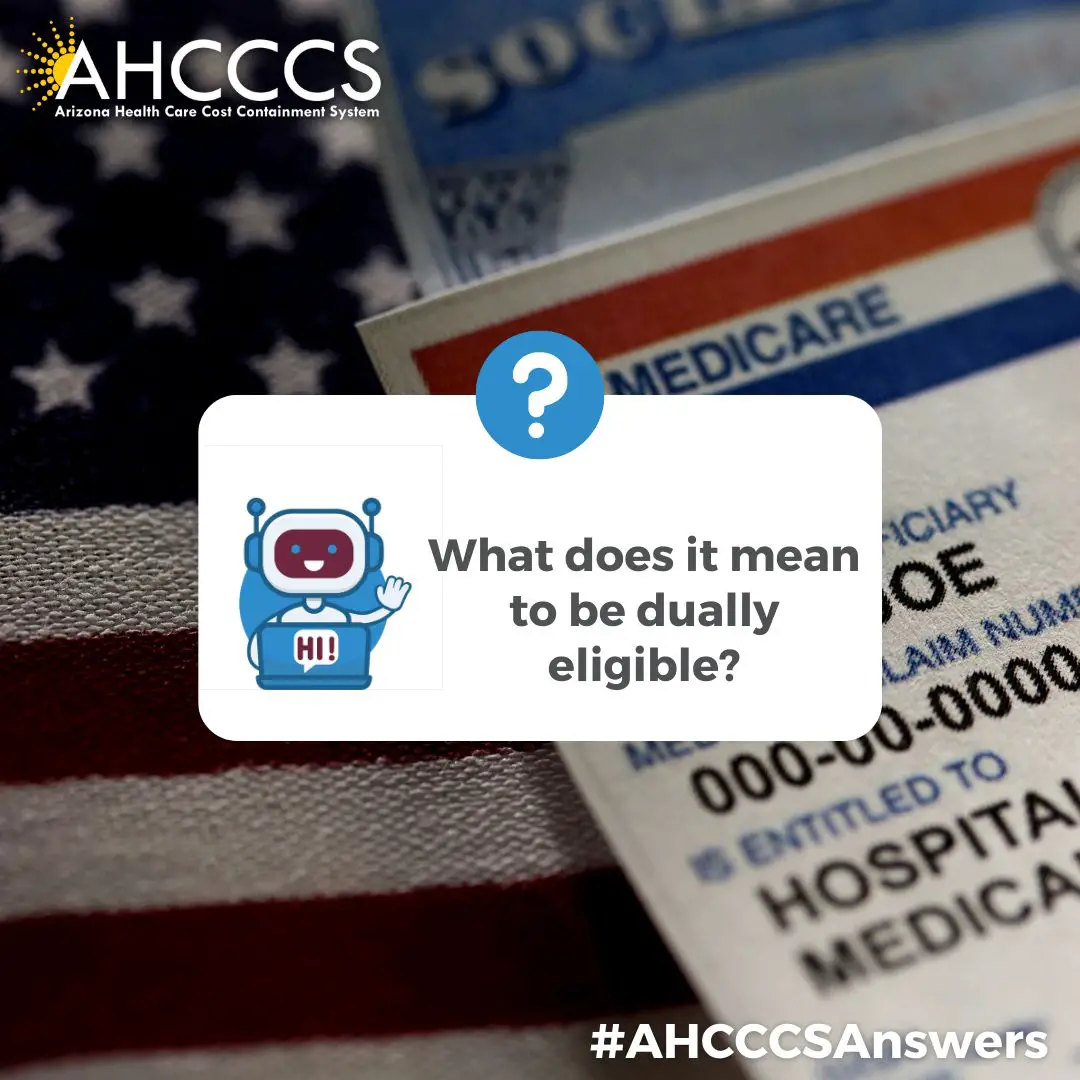Who Is Dual Eligible For Medicare And Medicaid
To be Medicare dual eligible, you have to meet the requirements for Medicare and your states Medicaid program.
To be eligible for Medicare, you must:
- Be at least 65 years old or having a qualifying disability
- Be a U.S. citizen or permanent legal resident
- Be eligible for benefits through Social Security or the Railroad Retirement Board
Generally speaking, Medicaid provides health insurance to low-income individuals and families, children and pregnant women. The best way to find out if you are eligible for Medicaid is to visit your states Medicaid website.
If you’re eligible for Medicaid and want to find out if you’re also eligible for a dual-eligible Medicare Medicaid plan, you can all to speak with a licensed insurance to find out if you’re eligible. An agent can help you compare the plans that are available where you live and find out what they may cover, which could include benefits like prescription drugs and other services.
Find $0 premium Medicare plans in your area
Or call 1-800-557-6059TTY Users: 711 24/7 to speak with a licensed insurance agent.
Medicare And Medicaid Dual Eligibility In 2022
by Christian Worstell | Published February 03, 2022 | Reviewed by John Krahnert
As of 2018, 12.2 million Americans are dual eligible beneficiaries of Medicare and Medicaid. This equals over 19% of the total Medicare population in that year.1
Medicare is the federally-administered health insurance program for people age 65 and over and people with qualifying disabilities.
Medicaid is a health insurance program for people with limited financial resources that is administered both by federal and state governments.
People who qualify for both Medicare and Medicaid benefits are dual eligible beneficiaries.
Having Dual Eligibility For Medicaid & Medicare: Who Is Eligible And Benefits
SummaryMedicaid is a health insurance program run by each individual state for people who are low-income, and Medicare is a national health insurance program for all Americans over 65. People who are eligible for both Medicaid and Medicare are considered dual eligibles. While some benefits are available through both programs, there are also differences in coverage that make dual eligibility a good way for many seniors to pay for their care needs. Only Medicaid, for example, pays for long-term nursing home care.
Read Also: Where Can I Get A 3d Ultrasound With Medicaid
Here Are Different Categories:
Health Services Not Covered By Medicare

Medicare is not an all-inclusive program. With rare exceptions, Original Medicare does not cover dental, hearing, and vision screening. That leaves beneficiaries to scramble for dentures, hearing aids, or corrective lenses . People who decide to enroll in Medicare Advantage may choose a plan that offers coverage for some of these services.
If your state Medicaid program offers these services, you may benefit from the added coverage. Not all states will offer coverage and if they do, it may not be available to everyone who qualifies for Medicaid.
Recommended Reading: Does Medicaid Cover Gym Memberships
How Do I Know If I Qualify For Medicaid And Medicare
Twelve million individuals are currently enrolled in both Medicaid and Medicare.1 These individuals are known as dual eligible beneficiaries because they qualify for both programs. As long as you meet the federal qualifications for Medicare eligibility and the state-specific qualifications for Medicaid eligibility, you will qualify as a dual eligible. To qualify for Medicare, individuals generally need to be 65 or older or have a qualifying disability.
There are several levels of assistance an individual can receive as a dual eligible beneficiary. The term full dual eligible refers to individuals who are enrolled in Medicare and receive full Medicaid benefits. Individuals who receive assistance from Medicaid to pay for Medicare premiums or cost sharing* are known as partial dual eligible.
*Cost sharing is the amount of your health care that you pay out of your own pocket. Typically, this includes deductibles, coinsurance, and copayments.
Dual Eligible Special Needs Plans
In some states, dual eligible beneficiaries may have the option of enrolling in a D-SNP, which is different from a traditional SNP or Special Needs Plan. These plans are specially designed to coordinate the care of dual eligible enrollees. Some plans may also be designed to focus on a specific chronic condition, such as chronic heart failure, diabetes, dementia, or End-Stage Renal Disease. These plans often include access to a network of providers who specialize in treating the specified condition. They may also include a prescription drug benefit that is tailored to the condition.
Also Check: Can I Get A Replacement Medicaid Card Online
Who Pays First If You Have Dual Eligibility
Since Medicaid is generally the payer of last resort, for dual eligible beneficiaries, Medicare pays covered medical services first.
If you have other coverage, such as employer group health plans or Medicare supplement plans , that coverage will pay first and Medicaid last.
Medicaid may cover healthcare costs that Medicare may not cover, or only partially covers, such as:
Who Is Dual Eligible For Medicare And Medicaid In 2022
If you meet the required qualifications for Medicare and Medicaid in 2020, you may be dual eligible.
To qualify for Medicare enrollment, you must be:
-
At least 65 years old or have a qualifying disability
-
A U.S. citizen or permanent legal resident for 5 continuous years
Because Medicare is a federal program, the standards for eligibility are the same everywhere in the U.S.
Medicaid is a state-run program, and each state may have its own rules for eligibility. If you have income or assets that under a certain amount that is determined by your state, you may be eligible for Medicaid in 2022.
Assets counted toward Medicaid eligibility can include things like money in savings accounts, stocks, real estate and vehicles. Visit your states Medicaid website to find out if you qualify.
Don’t Miss: Will Medicaid Pay For Birth Control
Can You Have Medicare And Medicaid At The Same Time
Medicare and Medicaid are both public health insurance programs. If you are dual eligible, you can have both Medicare and Medicaid coverage at the same time.
Two of the key differences between Medicare vs. Medicaid include:
- Medicare is for people age 65 and over and for certain people under 65 who have a qualifying disability. Medicare eligibility is consistent for everyone across the U.S., no matter what state you live in.
- Medicaid is for people of any age who meet certain income qualifications. Medicaid is administered by state governments, and eligibility requirements can differ between states.
Individuals Covered By Both Medicare And Medicaid
AHCCCS continues developing integration initiatives to increase alignment and improve service delivery for individuals covered by both Medicare and Medicaid. These individuals, commonly referred to as âdual eligible members,â navigate multiple health systems to receive care. This health system fragmentation often results in poor communication, uncoordinated health care decisions and a lack of a patient-centered perspective. AHCCCS has moved toward increasing the coordination of health service delivery between these two health programs by contracting with Medicare Advantage Dual Special Needs Plans that are each affiliated with its partner AHCCCS Complete Care Medicaid health plan. Requiring each ACC Medicaid health plan to offer a partner Medicare D-SNP promotes the enrollment or alignment of dual eligible members in the same health plan for both Medicare and Medicaid services to the greatest possible extent. Enrolling in specialized Medicare plans allows dual eligible members to receive all of their health care services, including prescription drug benefits, from a single, integrated health plan.
For more information regarding enrollment in an aligned Medicare D-SNP for 2021, please contact the plan you are interested in as shown below.
Recommended Reading: What Is A Medicaid Advantage Plan
How Do I Get Medicare Coverage If I Am Dual Eligible
You have the option of enrolling in Original Medicare or a Medicare Advantage Special Needs Plan.
Original Medicare includes Medicare Part A and Medicare Part B .
A Medicare Advantage Special Needs Plan bundles Part A and Part B together. Most Medicare Advantage plans also include prescription drug coverage and other health care benefits like hearing, vision and dental. They even provide extra benefits such as over-the-counter drug benefits and transportation assistance.
Qualified Disabled Working Individual Program

The QDWI Program helps pay for the Medicare Part A premium for certain people who meet one of the following criteria:
- Have a disability but are still working
- Lost their premium-free Part A coverage when they returned to work
- Are not receiving medical assistance from their state
- Meet the income and resource limits below
- Income of no more than $4,379 per month for an individual in 2021, or $5,892 for a married couple.
- Resources of $4,000 for an individual in 2021, or $6,000 for a married couple.
The income and resource limits listed above may increase in 2022. If your income and resources are slightly higher, you should still apply.
Recommended Reading: What Are The Requirements To Qualify For Medicaid
Medicare Dual Eligible Special Needs Plans
Another type of coverage that may be available to dual eligible beneficiaries is a Medicare Dual Eligible Special Needs Plan .
A Medicare special needs plan is a certain type of Medicare Advantage plan that is designed for people with specific health conditions or circumstances.
A D-SNP is built for the specific needs of dual eligibles. All Medicare SNPs provide prescription drug coverage.
What Is Medicare Dual Eligible And How Do I Qualify
Most Americans understand that when they turn 65, Medicare will become their main health insurance plan. However, many Americans are less familiar with another health care program, Medicaid, and what it means if they are eligible for both Medicare and Medicaid. If you are dual eligible, Medicaid may pay for your Medicare out-of-pocket costs and certain medical services that arent covered by Medicare.
Also Check: Does Medicaid Pay For Partial Dentures
Eligibility & How To Apply For Medicaid & Medicare
MedicareThere is no difference in eligibility criteria from state-to-state for Medicare its the same throughout the US. The broad requirements for Medicare eligibility are that the applicant must be the following: A U.S. citizen for at least 5 years before applying At least 65 years old or disabled.
To apply for Medicare, contact the nearest Social Security Office.
Medicaid Medicaid eligibility is complicated and will vary depending on several factors including ones financial situation and state of residence.
To enroll in Medicaid, ones monthly income and countable assets must be below a certain amount that, again, will vary depending on the state. Our Medicaid Long Term Care Eligibility Requirements Finder is a great place to start learning the eligibility requirements specific to your state, type of Medicaid and marital status.
For much more on eligibility for Medicaid, .
To apply for Medicaid, contact your nearest Medicaid office.
Definitions Of Dual Eligibility
Important factors that State and Federal policymakers face when designing care systems for dually eligible beneficiaries are the statutory definitions of dual eligibility. State Medicaid agencies are required to assist certain low-income Medicare beneficiaries with payment of Medicare premium and cost-sharing provisions. As described by Carpenter , the Medicare buy-in provision has expanded and evolved over time through a series of incremental expansions. For example, a Medicare beneficiary enrolled in Part A and/or Part B, who also receives State support in meeting any Medicare cost-sharing requirements may be considered a dually eligible beneficiary.
You May Like: What Are The Qualifications For Medicaid In Michigan
Aligning Your Medicare And Medicaid Health Care Coverage
The Arizona Health Care Cost Containment System recommends that dually eligible individuals align their health care coverage to get the best care.
Enrolling in the same health plan for Medicare coverage and Medicaid coverage is called alignment. When your health care coverage is aligned, your health plan can work better to provide the care that you need.
What Medicaid Covers For Medicare Enrollees
Medicare has four basic forms of coverage:
- Part A: Pays for hospitalization costs
- Part B: Pays for physician services, lab and x-ray services, durable medical equipment, and outpatient and other services
- Part C: Medicare Advantage Plan offered by private companies approved by Medicare
- Part D: Assists with the cost of prescription drugs
Medicare enrollees who have limited income and resources may get help paying for their premiums and out-of-pocket medical expenses from Medicaid . Medicaid also covers additional services beyond those provided under Medicare, including nursing facility care beyond the 100-day limit or skilled nursing facility care that Medicare covers, prescription drugs, eyeglasses, and hearing aids. Services covered by both programs are first paid by Medicare with Medicaid filling in the difference up to the state’s payment limit.
Don’t Miss: Where Can I Get A Medicaid Application
Unitedhealthcare Dual Complete Plans
Plans are insured through UnitedHealthcare Insurance Company or one of its affiliated companies, a Medicare Advantage organization with a Medicare contract and a contract with the State Medicaid Program. Enrollment in the plan depends on the plans contract renewal with Medicare. This plan is available to anyone who has both Medical Assistance from the State and Medicare. This information is not a complete description of benefits. Call TTY 711, or use your preferred relay service for more information. Limitations, co-payments, and restrictions may apply. Benefits, premiums and/or co-payments/co-insurance may change on January 1 of each year.
Levels Of Medicaid Coverage

Full dual eligible coverage
Qualifications for Medicaid vary by state, but, generally, people who qualify for full dual eligible coverage are recipients of Supplemental Security Income . The SSI program provides cash assistance to people who are aged, blind, or disabled to help them meet basic food and housing needs. The maximum income provided by the federal government for SSI in 2020 is $783 per month for an individual and $1,175 per month for a couple.2
To qualify for SSI, you must be under a specified income limit. Additionally, your assets must be limited to $2,000 for an individual and $3,000 for a couple.3 Qualifying assets typically include things like checking and savings accounts, stocks, real estate , and vehicles if you own more than one.
Partial dual eligible coverage
Individuals who are partial dual eligible typically fall into one of the following four Medicare Savings Program categories.
| Program | ||
|---|---|---|
|
Monthly income limit: $1,456 for an individual, $1,960 for a coupleResource limit: $7,860 for an individual, $11,800 for a couple |
Helps pay for Part B premiums |
|
|
Qualified Disabled Working Individual Program |
Monthly income limit: $4,339 for an individual, $5,833 for a coupleResource limit: $4,000 for an individual, $6,000 for a couple |
Pays the Part A premium for certain people who have disabilities and are working |
Don’t Miss: Walmart Eye Center That Accepts Medicaid
What Are The Benefits Of Being Dual Eligible In 2022
If you are dual eligible, you can benefit from both Medicare and Medicaid. You may also qualify for a Medicare Savings Program .
A Medicare Savings Program is a federally funded program administered by individual states that helps people who have limited financial resources pay for costs like Medicare premiums, deductibles, copayments and coinsurance.
There are four types of Medicare Savings Programs:
Qualified Medicare Beneficiary Program This program helps cover Medicare Part A and B premiums, deductibles, coinsurance and copayments.
Eligibility requires an income of no more than $1,094 per month for an individual or $1,472 per month for a married couple in 2021. If you had financial resources that total no more than $7,970 for an individual or $11,960 for a married couple in 2021, you may be eligible.
Specified Low-Income Medicare Beneficiary Program This program helps pay for Medicare Part B premiums.
Eligibility requires an income of no more than $1,308 per month for an individual or $1,762 per month as a married couple in 2021. If you had financial resources of less than $7,970 for an individual and $11,960 for a married couple in 2021, you may meet eligibility requirements.
Medicare Supplement Insurance Can Help Pay For Out
If you are dual eligible for Medicare and Medicaid, you may be able to apply for a Medicare Supplement plan thats available where you live.
A Medigap plan can help pay for some of your out-of-pocket costs such as deductibles or coinsurance.
If you are dual eligible for Medicare and Medicaid and enroll in a Medigap plan:
-
Your Original Medicare benefits will be the first payer for your health care services.
-
Then your Medigap plan benefits will help cover some additional costs, depending on which type of plan you have.
-
Finally, your Medicaid benefits will help pay for your remaining out-of-pocket costs for covered services.
A licensed insurance agent can help you learn more about your dual eligibility and how Medicare and Medicaid work with a Medicare Supplement plan.
Find Medicare Supplement plans in your area.
Also Check: Do I Have To Pay For Medicaid
What Is Pace For Medicare And Medicaid
Another Medicare and Medicaid program is PACE, or Programs of All-Inclusive Care for the Elderly.
PACE helps older Medicare beneficiaries to seek health care within their community, in their home and at PACE facilities.
Some of the things that can be covered by PACE include:
- Adult day primary care
- Caregiver training
- Transportation to a PACE facility when medically necessary
PACE is not strictly restricted to Medicare dual eligible beneficiaries. You may be eligible for PACE with only Medicare or only Medicaid .
However, you must meet all of the following conditions:
- Be at least 55 years old
- Live in the service area of a PACE organization
- Require a nursing home-level of care
- Be able to live safely in the community with help from PACE